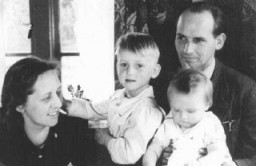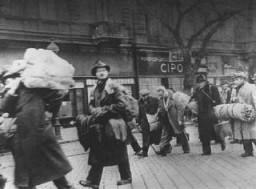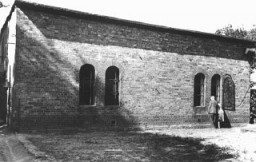![Tablecloth with roses embroidered by her mother carried by 17 year old Hannah Kronheim when she left Germany on the Kinderstransport [Children's Transport] in 1939.](https://encyclopedia.ushmm.org/images/large/e30b9048-1191-4b70-a837-5026376d2fef.jpg)
Kindertransport, 1938–40
Kindertransport (Children's Transport) was the informal name of a series of rescue efforts between 1938 and 1940. These rescue efforts brought thousands of refugee children, the vast majority of them Jewish, to Great Britain from Nazi Germany.
-
1
In the wake of antisemitic violence coordinated by the Nazi regime in Germany in November 1938, the British government allowed unaccompanied minors under the age of 17 from the German Reich (including recently annexed territories) to enter Great Britain as refugees.
-
2
Jewish organizations inside the Greater German Reich planned the transports to Great Britain. Child welfare organizations in Great Britain arranged for the children’s care, education, and eventual emigration from Britain.
-
3
From December 1938 until May 1940, the Kindertransport efforts brought about 10,000 children to safety in Great Britain.
Background
Kindertransport, 1938–40: Oral Histories Nazi authorities staged a violent pogrom upon Jews in Germany on November 9–10, 1938. This event is known as Kristallnacht (Night of Broken Glass). After the pogrom, the British government eased immigration restrictions for certain categories of Jewish refugees. British authorities agreed to allow an unspecified number of unaccompanied minors under the age of 17 to enter Great Britain from Germany and German-annexed territories (that is, Austria and the Czech lands). They were spurred by British public opinion and the persistent efforts of refugee aid committees. Notable among the refugee aid committees were the British Committee for the Jews of Germany and the Movement for the Care of Children from Germany.
Private citizens or organizations had to guarantee payment for each child's care, education, and eventual emigration from Britain. In return, the British government agreed to allow unaccompanied refugee children to enter the country on temporary travel visas. It was understood at the time that when the “crisis was over,” the children would return to their families. Parents or guardians could not accompany the children. The few infants included in the program were cared for by other children on their transport.
The Transports
The first Kindertransport arrived in Harwich, Great Britain, on December 2, 1938. It brought some 200 children from a Jewish orphanage in Berlin which had been destroyed in the Kristallnacht pogrom. Most transports left by train from Berlin, Vienna, Prague, and other major cities in central Europe. Children from smaller towns and villages traveled from their homes to these collection points in order to join the transports.
Jewish organizations within the Greater German Reich (which in 1938 included Germany, Austria, and the Sudetenland) planned the transports. These organizations were the Reich Representation of Jews in Germany, headquartered in Berlin; after early 1939, its successor organization the Reich Association of Jews in Germany; and the Jewish Community Organization (Kultusgemeinde) in Vienna. They generally favored children whose emigration was urgent because their parents were in concentration camps or were no longer able to support them. They also gave priority to homeless children and orphans.
Children chosen for a Kindertransport convoy traveled by train to ports in Belgium and the Netherlands. From these ports, they sailed to Harwich. At least one of the early transports left from the port of Hamburg in Germany. Some children from Czechoslovakia (which was dismantled by Germany between September 1938 and March 1939) were flown by plane directly to Britain. The last transport from Germany left on September 1, 1939, just as World War II began. The last transport from the Netherlands left for Britain on May 14, 1940, the same day that the Dutch army surrendered to German forces.
Arrival in Harwich
After the transports arrived in Harwich, children with sponsors went to London to meet their foster families. Children without sponsors were housed in a summer camp in Dovercourt Bay and in other facilities until individual families agreed to care for them or until hostels could be organized to care for larger groups of children.
Many organizations and individuals participated in the rescue operation. Inside Britain, the Movement for the Care of Children from Germany coordinated many of the rescue efforts. Jews, Quakers, and Christians of many denominations worked together to bring refugee children to Britain. About half of the children lived with foster families. The others stayed in hostels, schools, or on farms throughout Great Britain.
In all, the rescue operation brought about 10,000 children from Germany, Austria, Czechoslovakia, and Poland to Great Britain. The vast majority of these children were Jewish.
Enemy Aliens
With the outbreak of World War II, refugees from Germany residing in Great Britain were increasingly seen as a security threat. Thus they were treated as “enemy aliens”—in this context meaning citizens of a country with whom England was at war and who were currently residing on English soil. This fact, in combination with a rise in unemployment and antisemitism, had a direct impact on some of the children brought from Germany to Great Britain as refugees. In particular, teenage children who held German citizenship were considered susceptible to foreign political influence.
In 1940, British authorities interned as enemy aliens about 1,000 older children from the Kindertransport. They were held in internment camps on the Isle of Man, Canada, and Australia. Despite their classification as enemy aliens, some of the boys from the children's transport program later joined the British army and fought in the war against Germany.
After the War
Many children from the children's transport program became citizens of Great Britain, or emigrated to Israel, the United States, Canada, and Australia. Most of them would never again see their parents, who were murdered during the Holocaust.
Series: Rescue and Resistance during the Holocaust
Critical Thinking Questions
- What pressures and motivations drove parents to send their children to Great Britain through this program?
- What pressures and motivations may have influenced British families to take in children from Europe?
- Officials in the United States proposed a similar program. What was the result?
- How did the United States and other countries interpret their role when facing a catastrophic refugee crisis in 1939?
Further Reading
Dubrovsky, Gertrude W. Six from Leipzig. London: Vallentine Mitchell, 2004.
Emanuel, Murial and Vera Gissing. Nicholas Winton and the Rescued Generation. London: Vallentine Mitchell, 2001.
Guske, Iris. Trauma and Attachment in the Kindertransport Context: German-Jewish Child Refugees' Accounts of Displacement and Acculturation in Britain. Newcastle: Cambridge Scholars, 2009.
Harris, Mark Jonathan, and Deborah Oppenheimer. Into the Arms of Strangers: Stories of the Kindertransport. New York: Bloomsbury, 2018.
Korobkin, Frieda Stolzberg. Throw Your Feet Over Your Shoulders: Beyond the Kindertransport. New York: Devora, 2008.
Leverton, Bertha, and Shmuel Lowensohn, editors. I Came Alone: The Stories of the Kindertransports. Sussex, England: Book Guild, 1990.









